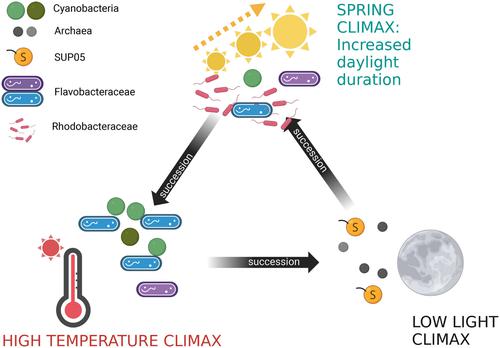当前位置:
X-MOL 学术
›
Environ. Microbiol.
›
论文详情
Our official English website, www.x-mol.net, welcomes your
feedback! (Note: you will need to create a separate account there.)
Annual recurrence of prokaryotic climax communities in shallow waters of the North Mediterranean
Environmental Microbiology ( IF 4.3 ) Pub Date : 2024-02-29 , DOI: 10.1111/1462-2920.16595 Mauro Celussi 1, 2 , Vincenzo Manna 1, 2 , Elisa Banchi 1, 2 , Viviana Fonti 1 , Matteo Bazzaro 1 , Vesna Flander-Putrle 3 , Katja Klun 3 , Martina Kralj 1 , Neža Orel 3 , Tinkara Tinta 3
Environmental Microbiology ( IF 4.3 ) Pub Date : 2024-02-29 , DOI: 10.1111/1462-2920.16595 Mauro Celussi 1, 2 , Vincenzo Manna 1, 2 , Elisa Banchi 1, 2 , Viviana Fonti 1 , Matteo Bazzaro 1 , Vesna Flander-Putrle 3 , Katja Klun 3 , Martina Kralj 1 , Neža Orel 3 , Tinkara Tinta 3
Affiliation

|
In temperate coastal environments, wide fluctuations of biotic and abiotic factors drive microbiome dynamics. To link recurrent ecological patterns with planktonic microbial communities, we analysed a monthly‐sampled 3‐year time series of 16S rRNA amplicon sequencing data, alongside environmental variables, collected at two stations in the northern Adriatic Sea. Time series multivariate analyses allowed us to identify three stable, mature communities (climaxes), whose recurrence was mainly driven by changes in photoperiod and temperature. Mixotrophs (e.g., Ca. Nitrosopumilus , SUP05 clade, and Marine Group II) thrived under oligotrophic, low‐light conditions, whereas copiotrophs (e.g., NS4 and NS5 clades) bloomed at higher temperatures and substrate availability. The early spring climax was characterised by a more diverse set of amplicon sequence variants, including copiotrophs associated with phytoplankton‐derived organic matter degradation, and photo‐auto/heterotrophic organisms (e.g., Synechococcus sp., Roseobacter clade), whose rhythmicity was linked to photoperiod lengthening. Through the identification of recurrent climax assemblages, we begin to delineate a typology of ecosystem based on microbiome composition and functionality, allowing for the intercomparison of microbial assemblages among different biomes, a still underachieved goal in the omics era.
中文翻译:

北地中海浅水区原核顶极群落的年度复发
在温带沿海环境中,生物和非生物因素的广泛波动驱动着微生物群的动态。为了将循环生态模式与浮游微生物群落联系起来,我们分析了在亚得里亚海北部两个站收集的每月采样的 3 年时间序列的 16S rRNA 扩增子测序数据以及环境变量。时间序列多变量分析使我们能够识别出三个稳定、成熟的群落(高潮),其复发主要由光周期和温度的变化驱动。混合营养生物(例如 Ca.亚硝草属、 SUP05 分支和 Marine Group II)在寡营养、弱光条件下繁盛,而富营养型(例如 NS4 和 NS5 分支)在较高温度和底物可用性下繁盛。早春高潮的特点是一组更加多样化的扩增子序列变体,包括与浮游植物衍生的有机物降解相关的富营养生物和光自/异养生物(例如,聚球藻属sp.,Roseobacter clade),其节律与光周期延长有关。通过识别反复出现的高潮组合,我们开始根据微生物组的组成和功能来描绘生态系统的类型,从而可以对不同生物群落之间的微生物组合进行相互比较,这是组学时代仍未实现的目标。
更新日期:2024-02-29
中文翻译:

北地中海浅水区原核顶极群落的年度复发
在温带沿海环境中,生物和非生物因素的广泛波动驱动着微生物群的动态。为了将循环生态模式与浮游微生物群落联系起来,我们分析了在亚得里亚海北部两个站收集的每月采样的 3 年时间序列的 16S rRNA 扩增子测序数据以及环境变量。时间序列多变量分析使我们能够识别出三个稳定、成熟的群落(高潮),其复发主要由光周期和温度的变化驱动。混合营养生物(例如 Ca.亚硝草属、 SUP05 分支和 Marine Group II)在寡营养、弱光条件下繁盛,而富营养型(例如 NS4 和 NS5 分支)在较高温度和底物可用性下繁盛。早春高潮的特点是一组更加多样化的扩增子序列变体,包括与浮游植物衍生的有机物降解相关的富营养生物和光自/异养生物(例如,聚球藻属sp.,Roseobacter clade),其节律与光周期延长有关。通过识别反复出现的高潮组合,我们开始根据微生物组的组成和功能来描绘生态系统的类型,从而可以对不同生物群落之间的微生物组合进行相互比较,这是组学时代仍未实现的目标。











































 京公网安备 11010802027423号
京公网安备 11010802027423号